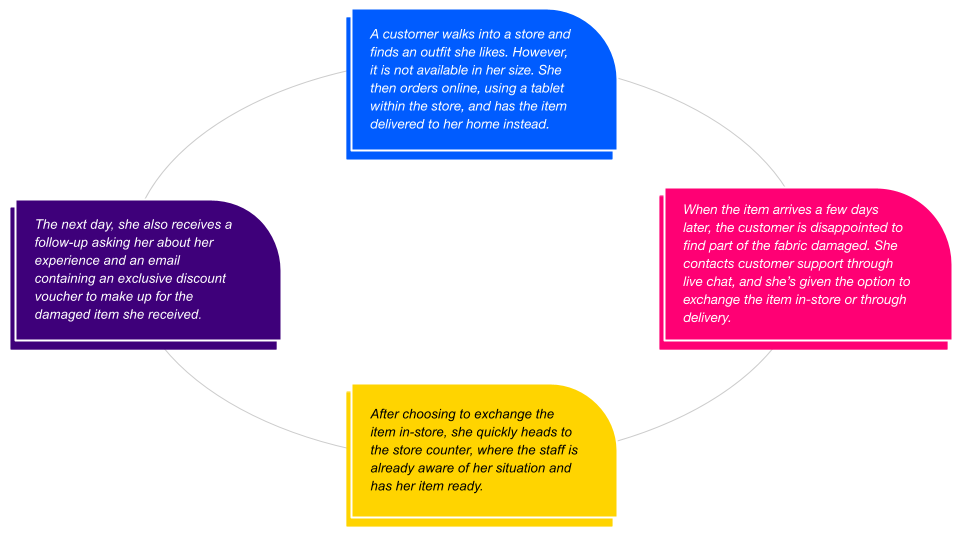Industry Knowledge
Omnichannel Customer Service: Designing a Cohesive User Experience at Every Touchpoint
Omnichannel customer service is now a necessity for brands to meet customer expectations, stay competitive, and drive growth.
In the mind of every highly-expectant consumer, they should be able to:
- contact a brand using any channel they want,
- at any time they please,
- without having to wait a long time, and
- without having to repeat their issue to every customer service representative.
On top of it all, everything has to be quick, hassle-free, and “goes-the-extra-mile.” That’s just how it is nowadays.
In today’s highly competitive landscape, convenience is king, there are many boxes to tick, and all these enhancements to customer experiences are just table stakes. If your brand isn’t keeping up, you’ll be left behind in an instant. Fortunately, there’s a solution: omnichannel customer service.
What exactly is an omnichannel customer experience?
From mom-and-pop to big-box store formats, the retail industry has always found a way to reinvent itself. Now, the changes have become fast-paced and drastic. In-store versus online shopping became in-store pickup to “trying before buying” to “order online, return in-store,” and so much more. All that to finally arrive at a retail model that combines the best of all words—the omnichannel customer experience.
Omnichannel customer service, however, isn’t simply about retailers being everything, everywhere—all at once; it is about providing customers with what they need, when, and where they want it. Let’s look at an example of what makes omnichannel customer experience great:

Giving customers a seamless experience across channels (both physical and digital) with no disruptions and without sacrificing context—that’s what omnichannel customer support is all about.
In the example above, the customer’s needs were met quickly and smoothly thanks to the seamless integration of all channels. It turned what could have been a bad experience into a great one thanks to all the proactive care the company gave through each touchpoint. All this makes excellent eCommerce customer service.

Omnichannel vs. Multichannel. A Big Difference.
We often see the terms “omnichannel” and “multichannel” and assume they mean the same thing. However, they have a significant distinction that gives them varying functions—integration.
Omnichannel customer support is all about integrating, unifying, and synching communications across channels. Implementing these initiatives helps provide the customer with a consistent communications journey, wherever they may be. So if a customer starts a conversation through the brand’s social media customer service today but decides to call in another day, the conversation would continue smoothly even if a different customer service representative answers the call.
On the other hand, a multichannel approach can’t continue a conversation from one channel to another. Multichannel customer support offers multiple channels for customers to choose from, but they aren’t necessarily integrated. Each channel runs separately, meaning other teams have no access to the customer’s history, making the customer experience less seamless and more complicated.
While both multichannel and omnichannel customer service provide the customer with various ways to access the brand through multiple channels such as email and live chat support, the experiences are different. In a world where convenience is a must, a multichannel approach isn’t enough.
78% of consumers expect a personalized experience.
If brands want to keep up with today’s tenacious shoppers, stay ahead of the competition, and increase customer retention, omnichannel is the way to go. Omnichannel customer service puts the customer at the center, focusing on their needs and providing them with a personalized message in a seamless, unified experience.
If Convenience is King, Omnichannel is Queen: The Need for an Omnichannel Strategy
The level of competition in the marketplace has reached an all-time high. Companies are no longer solely vying for customers based on price or product value but on the entire customer experience. Here are the top reasons why brands should consider investing in omnichannel customer service:
| Almost 100% | of shoppers value convenience in their shopping experience, and they’re ready to abandon the brand if an experience is inconvenient. |
| 66% | of customers like to use at least three communication channels when interacting with a business. Speed, convenience, expert assistance, and friendly service are considered key components of a positive customer experience. |
| 76% | of consumers say they want a consistent experience across all channels, including phone, in-person interactions, social media, and more. |
| 66% | of customers expect brands to know and understand what they want and be treated as valued individuals. |
| 52% | of Americans favor a mobile-friendly or convenient app customer experience. |
| 60% | increased profitability for customer-centric companies. They’re also more likely to have highly productive and highly engaged teams. |
| 20% - 80% | growth and competitive advantage for businesses investing in omnichannel customer service. |
| 59% | of consumers say that self-service options elevate their experience with a brand. |
One thing is clear: excellent customer experiences pay off. With so many brands vying for customers' attention, providing a superior customer experience is more important than ever. By integrating omnichannel customer support, brands can easily meet the listed customer demands above and differentiate themselves from the competition.
How TaskUs Approaches the Omnichannel Experience
Companies must strive to deliver excellent products, marketing, experiences, and services while proving they have the customer’s best interests at heart.
The intricacies of omnichannel customer service sometimes lead businesses to get so caught up in the need to be omnipresent that they end up missing the ultimate end goal: engaging with customers in a meaningful way. If you involve the customer in the experience—through whatever channel—they will be more engaged and interested.
For example, one of our clients, the world’s largest eCommerce platform, was growing too fast and was struggling to handle customer support on its own. Aligned with their people-centric culture and with proven capabilities to support their complex care environment, they decided to partner with Us. The results:
- 91% improved Customer Satisfaction (CSAT) from 79%
- $2,300 annual revenue per agent contributing to increased sales
- 3x increase in agent count with no degradation of service

Not only did we deliver higher CSAT scores, we helped our partner client reduce costs without negatively impacting service levels.
Recognized by the Everest Group as the World's Fastest Business Process (Outsourcing) Service Provider in 2022 and with glowing reviews in Gartner Peer Insights Review, TaskUs continues to deliver excellent omnichannel customer service using our proven formula: merchant success + individual empowerment + enhanced training.
- 1^Producing Customer Convenience with Market Research - Pollfish Resources
- 2^The value of getting personalization right—or wrong—is multiplying | McKinsey
- 3^2017 State Of Global Customer Service Report
- 4^What Are Customer Expectations, and How Have They Changed? - Salesforce.com
- 5^How to Create a Customer Centric Strategy For Your Business
- 6^PWC - Retailing 2020
- 7^The Millennialization of Customer Service | Nuance
- 8^TaskUs Customer Service BPO Services Reviews
References

We exist to empower people to deliver Ridiculously Good innovation to the world’s best companies.
Useful Links







